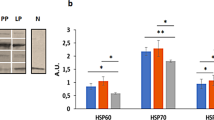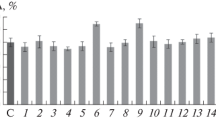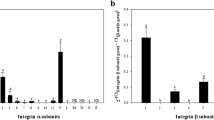Abstract
We have examined the influence of transforming agents on the in vitro modulation of the 90 kDa heat-shock protein (hsp-90) associated with the calf uterine progesterone receptor (PR). This analysis was facilitated by the use of αPR6 (Sullivan et al. 1986) (anti-PR monoclonal antibody that recognizes 110 kDa protein of chicken PR, subunit PR-B), which was seen to shift the rate of sedimentation of the untransformed (8S) and thermally transformed (4S) [3H]R5020-receptor complexes from the calf uterine cytosol toward the bottom of the tube. Silver staining of the αPR6-purified calf uterine cytosol revealed the presence of two major proteins with Mr 114 kDa and 90 kDa. Affinity-labeling of uterine cytosol with [3H]R5020, however, yielded only one major protein of 114 kDa. Incubation of uterine cytosol with AC88 (Riehl et al. 1985), a monoclonal antibody that recognizes hsp-90, resulted in a precipitation of a single 90 kDa protein which showed electrophoretic mobility similar to the second protein precipitated with αPR6. Western blot analysis confirmed that αPR6 interacts only with the 114 kDa cytosol protein representing the calf uterine PR. Incubation of PR complexes at 23°C or at 0°C with 0.3 M KCI or 10 mM ATP also caused the dissociation of hsp-90 from the 114 kDa PR protein, although thermal transformation was less effective in dissociating hsp-90 from PR when the ligand binding site was occupied by the antiprogestin RU486. The presence of iodoacetamide (IA) stabilized the nontransformed RU486-bound PR against thermal transformation while there was dissociation of hsp-90 from the R5020-receptor complexes. Results of our study demonstrate that calf uterine PR is represented by a major steroid binding protein of 114kDa that exists in association with hsp-90. Exposure to transforming conditions leads to dissociation of receptor-associated hsp-90. Furthermore, the inability of IA-treated RU486-occupied PR to transform suggests that transformation of agonist-bound PR involves SH-groups which must be protected from the inactivating influence of IA.
Similar content being viewed by others
Abbreviations
- EDTA:
-
Ethylenediamine Tetraacetate
- Hsp-90:
-
90kDa Heat-shock protein
- IA:
-
Iodoacetamide
- MTG:
-
Monothioglycerol
- P:
-
Progesterone
- PAGE:
-
Polyacrylamide Gel Electrophoresis
- PMSF:
-
Phenylmethylsulfonyl Fluoride
- PR:
-
Progesterone Receptor
- αPR6:
-
Anti-PR monocloncal antibody
- PRc:
-
Progesterone Receptor complex
- R5020:
-
17, 21-dimethyl pregna-4,9(10)-diene-3,20-diene
- RU486:
-
17β-hydroxy-11β-[4-(dimethyl-amino)phenyl]-17α-(prop-1-ynyl)estra-4,9-dien-3-one
- SDS:
-
Sodium Dodecyl Sulfate
- Tris:
-
Tris (hydroxymethyl) aminomethane
References
Moudgil VK, Eessalu TE, Buchou T, Renoir JM, Mester J, Baulieu EE: Transformation of chick oviduct progesterone receptor in vitro: Effects of hormone, salt, heat and adenosine triphosphate. Endocrinology 116: 1267–1274, 1985
Grody WW, Schrader WT, O'Malley BW: Activation, transformation, and subunit structure of steroid hormone receptors. Endo Rev 3: 141–163, 1982
Milgrom E: Activation of steroid-receptor complexes. Biochem Action Hormones 13: 465–492, 1981
Schmidt TJ, Litwack G: Activation of the glucocorticoid-receptor complex. Physiol Rev 62: 1131–1192, 1982
Puri RK, Toft DO: Transformation of highly purified avian progesterone receptor. Endocrinology 115: 2453–2463, 1984
Moudgil VK, Vandenheede L, Hurd C, Eliezer N, Lombardo G: In vitro modulation of rat liver glucocorticoid receptor by urea. J Biol Chem 262: 5180–5187, 1987
Moudgil VK, Hurd C: Transformation of calf uterine progesterone receptor: Analysis of the process when receptor is bound to progesterone and RU38486. Biochemistry 26: 4993–5001,1987
Hurd C, Moudgil VK: Characterization of R5020 and RU486 binding to progesterone receptor from calf uterus. Biochemistry 27: 3618–3623, 1988
Baulieu EE: Contragestion and other clinical applications of RU 486, and antiprogesterone at the receptor. Science 245:1351–1357,1989
Anter MJ, Chan K, Spyridakis C, Moudgil VK: Role of sulfhydryl groups in the R5020 and RU486 binding and activation of progesterone receptor from calf uterus (Abstr 183). Proc Endo Soc Meet, Indianapolis, June 10–12, 1987
Moudgil VK, Anter MJ, Hurd C: Mammalian progesterone receptor shows differential sensitivity to sulfhydryl group modifying agents when bound to agonist and antagonist ligands. J Biol Chem 264: 2203–2211, 1989
Catelli MG, Binart N, Jung-Testas I, Renoire JM, Baulieu EE, Fergmisco JR, Welch WJ: The common 90-Kd protein component of non-transformed ‘8S’ steroid receptors is a heat-shock protein. EMBO J 4: 3131–3135, 1985
Baulieu EE: Antisteroid hormones, receptor structure and heat-shock protein MW 90,000 (hsp 90). In: VK Moudgil (ed.) Steroid Receptors in Health and Disease, Plenum Press, New York, 1988, pp 251–262
Sullivan WP, Beito TG, Proper J, Krco CJ, Toft DO: Preparation of monoclonal antibodies to the avian progesterone receptor. Endocrinology 119: 1549–1557, 1986
Reihl RM, Sullivan WP, Vroman BT, Bauer VJ, Pearson GR, Toft DO: Immunological evidence that nonhormone binding component of avian steroid receptors exist in a wide variety of tissues and species. Biochemistry 24: 6586–6591, 1985
Anton D, Kutny R: Escherichia coli S-adenosylmethionine decarboxylase. Subunit structure, reductive amination, and NH,-terminal sequences. J Biol Chem 262: 2817–2822,1987
Singh VB, Moudgil VK: Phosphorylation of rat liver glucocorticoid receptor. J Biol Chem 260: 3684–3690, 1985
Merril CR, Goldman D, Sedman SA, Ebert MH: Ultrasensitive stain for proteins in polyacrylamide gels shows regional variation in cerebrospinal fluid proteins. Science 211: 1437–1438,1981
Blake MS, Johnston KH, Russel-Jones GJ, Gotschlich EC: A rapid, sensitive method for detection of alkaline phosphatase-conjugated antibody on Western blots. Anal Biochem 136: 175–179, 1984
Joab I, Radanyi C, Renoir M, Buchou T, Catelli MG, Binart N, Mester J, Baulieu EE: Common non-hormone binding component in nontransformed chick oviduct receptors of four steroid hormones. Nature (London) 308: 850–853, 1984
Gray GO, Satyaswaroop PG: Species crossreactivity of human progesterone receptor monoclonal antibodies: Western blot analysis. Biochem Biophys Res Commun 157: 1067–1077,1988
Horwitz KB, Alexander PS: In situ photolinked nuclear progesterone receptors of human breast cancer cells; subunit molecular weights after transformation and translocation. Endocrinology 113: 2195–2201, 1983
Sheridan PL, Francis MD, Horwitz KB: Synthesis of human progesterone receptors in T47D cells. Nascent A- and B-receptors are active without a phosphorylation-dependent post-translational maturation step. J Biol Chem 264: 7054–7058,1989
Nishigori H, Toft DO: Inhibition of progesterone receptor activation by sodium molybdate. Biochemistry 19: 77–83, 1980
Sanchez ER, Housley PR, Pratt WP: The molybdate-stabilized glucocorticoid binding complex of L-cells contains a 98–100 K dalton steroid binding phosphoprotein and a 90 K dalton nonsteroid binding phosphoprotein that is not a part of the murine heat-shock complex. J Steroid Biochem 24: 9–18,1986
Sanchez ER, Toft DO, Schlesinger MJ, Pratt WB: Evidence that the 90 kDa phosphoprotein associated with the untransformed L-cell glucocorticoid receptor is a murine heat-shock protein. J Biol Chem 260: 12398–12401, 1985
Sanchez ER, Meshinchi S, Tienrungroj W, Schlesinger MJ, Toft DO, Pratt WB: Relationship of the 90-kDa murine heat-shock protein to the untransformed and transformed states of the L-cell glucocorticoid receptor. J Biol Chem 262: 6986–6991, 1987
Mendel DB, Bodwell JE, Gametchu B, Harrison RW, Munck A: Molybdate-stabilized nonactivated glucocorticoid-receptor complexes contain a 90-kDa non-steroidbinding phosphoprotein that is lost on activation. J Biol Chem 261: 3758–3763, 1986
Renoir JM, Buchou T, Baulieu EE: Involvement of a nonhormone-binding 90-kilodalton protein in the nontransformed 8S form of the rabbit uterus progesterone receptor. Biochemistry 25: 6405–6413, 1986
Denis M, Wikstrom AC, Gustafsson JA: The molybdatestabilized nonactivated glucocorticoid receptor contains a dimer of Mr 90,000 non-hormone-binding protein. J Biol Chem 262: 11803–11806, 1987
Ramchandran C, Catelli MG, Schneider W, Shyamala G: Estrogenic regulation of uterine 90-kilodalton heat-shock protein. Endocrinology 123: 956–961, 1988
Howard KJ, Distelhorst CW: Evidence for intracellular association of the glucocorticoid receptor with the 90-kDa heat-shock protein. J Biol Chem 263: 3474–3481, 1988
Lefebre P, Danze PM, Sablonniere B, Richard C, Formstecher P, Dautrevaux M: Association of the glucocorticoid receptor binding subunit with the 90K nonsteroid-binding component is stabilized by both steroidal and nonsteroidal antiglucocorticoids in intact cells. Biochemistry 27: 9186–9194, 1988
Author information
Authors and Affiliations
Rights and permissions
About this article
Cite this article
Hurd, C., Nakao, M., Eliezer, N. et al. Immunoanalysis of calf uterine progesterone receptor: Modulation of receptor-associated 90 kDa heat-shock protein. Mol Cell Biochem 105, 73–83 (1991). https://doi.org/10.1007/BF00230376
Received:
Accepted:
Issue Date:
DOI: https://doi.org/10.1007/BF00230376




